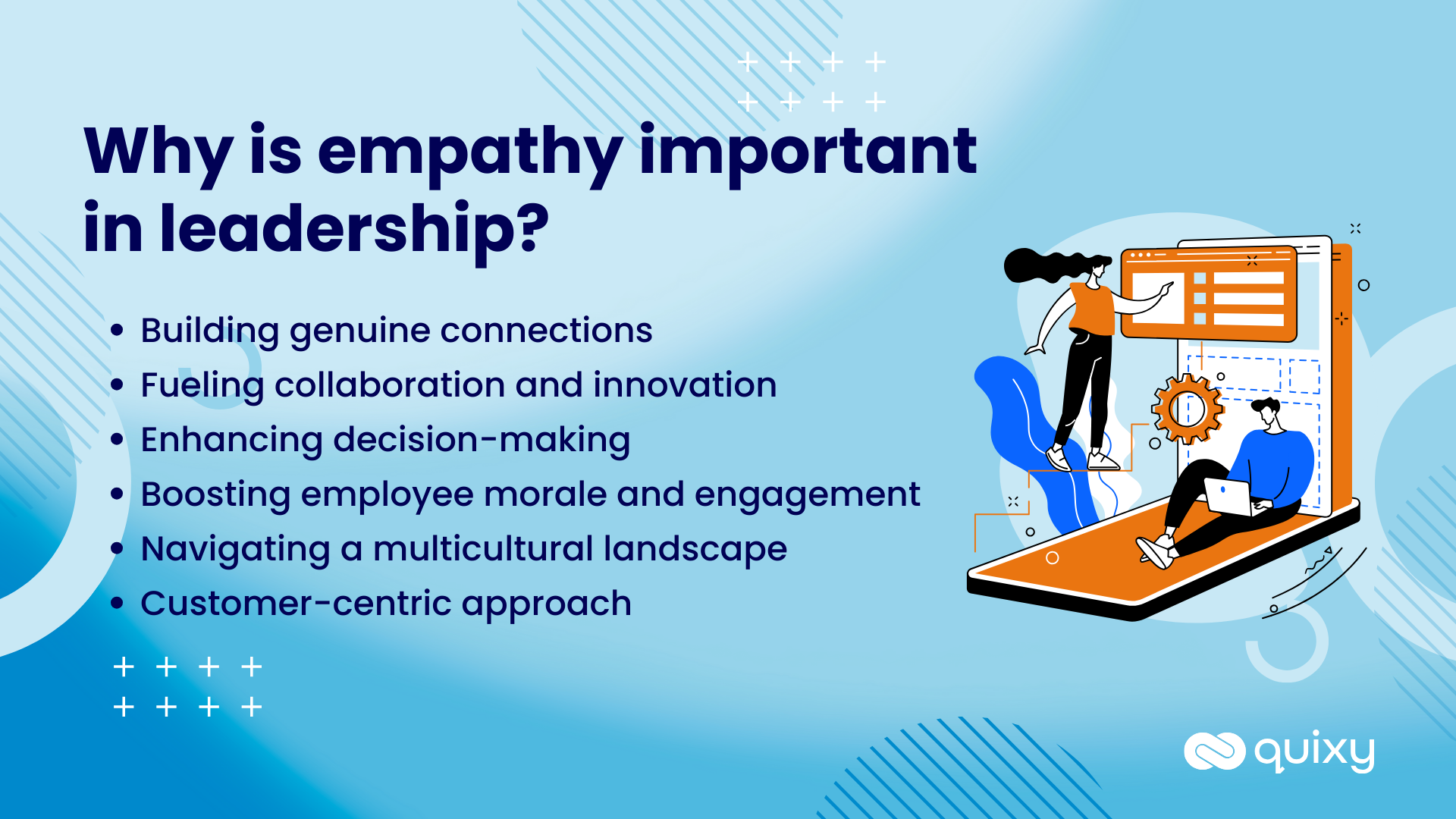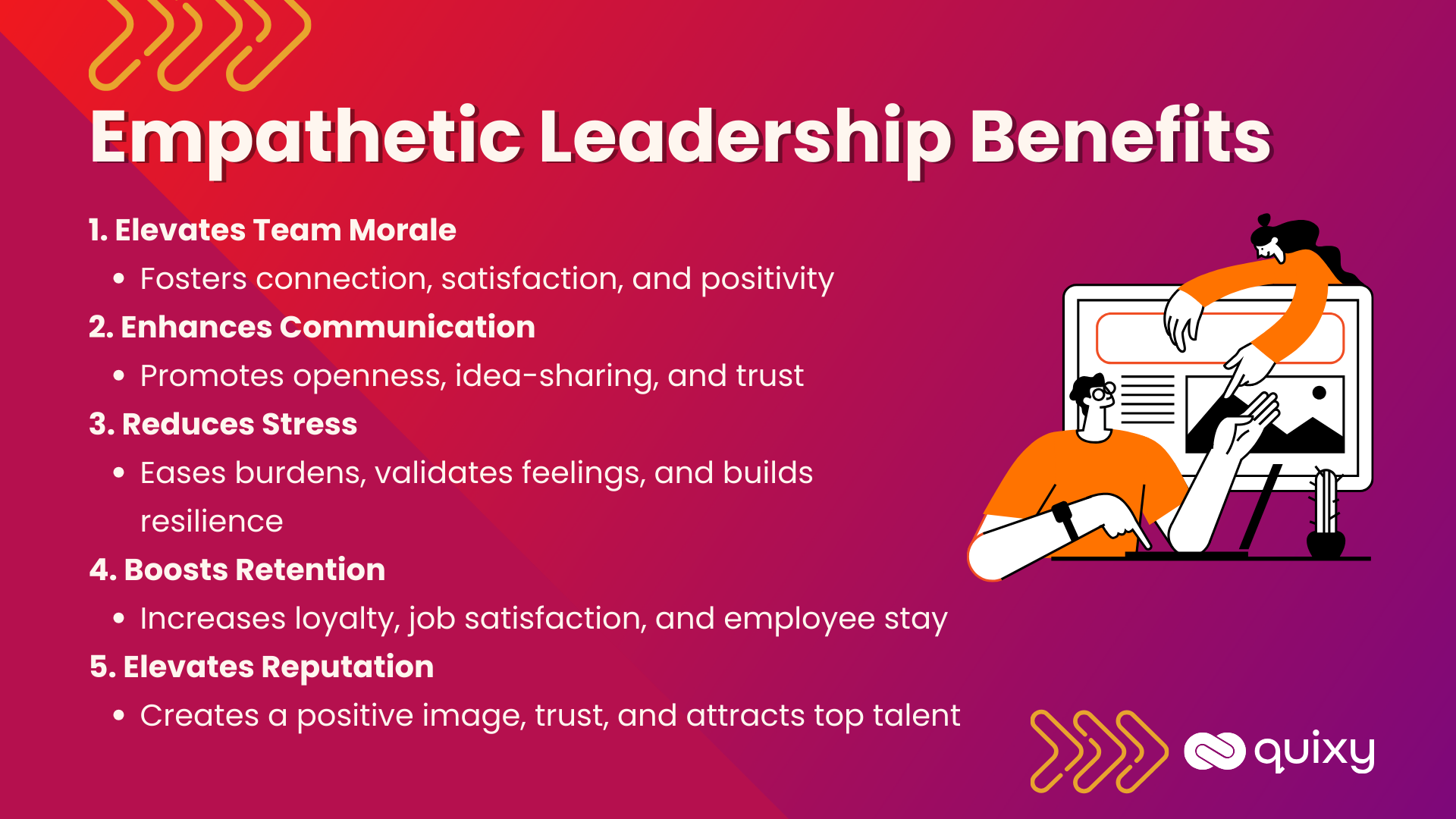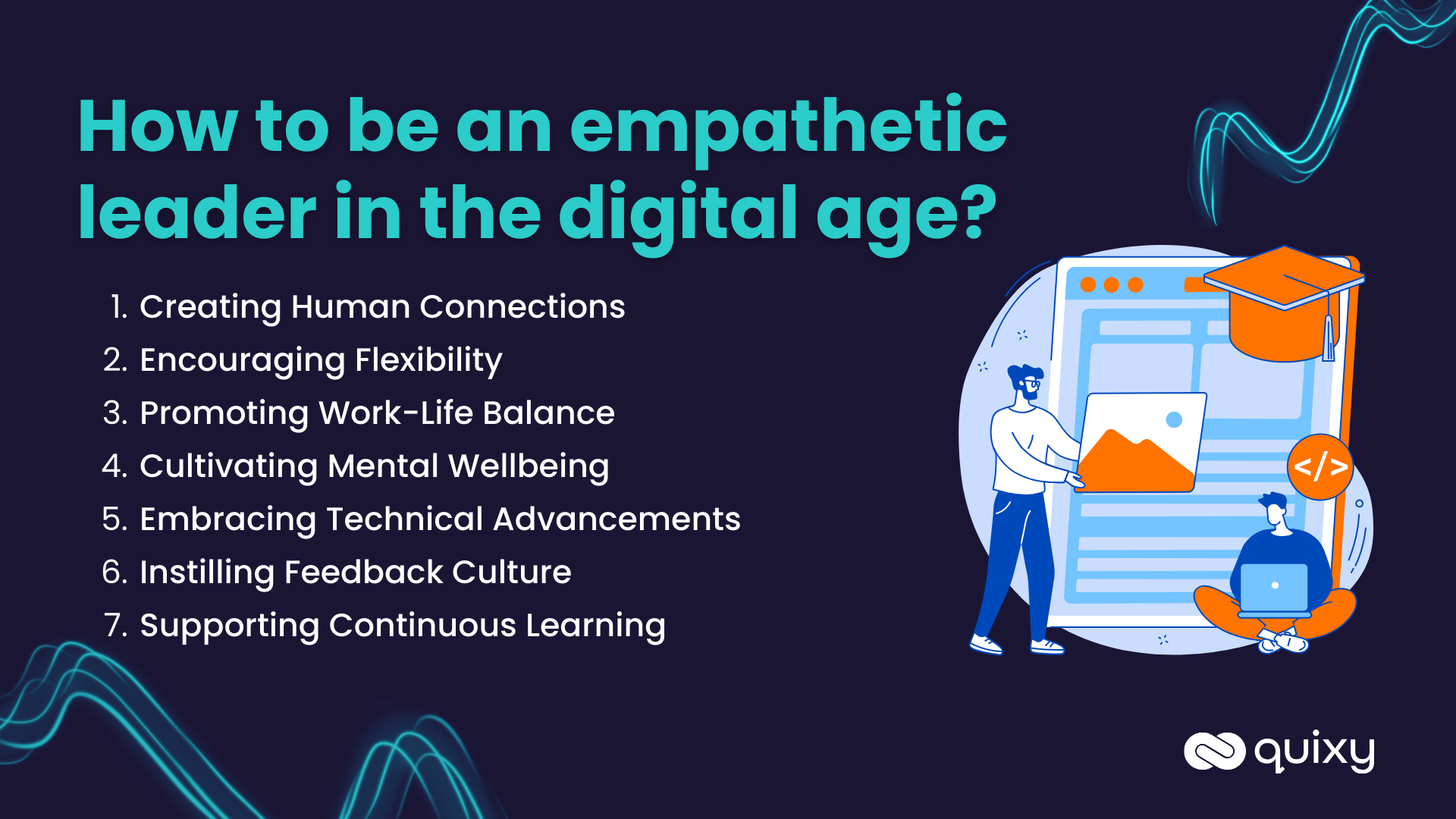
In an era defined by technology and virtual interactions, the essence of leadership is evolving. But how do you excel in balancing tech and human touch? Empathetic leadership in the digital age is the answer. It’s about understanding that behind every email, video call, or chat message is a human with feelings, aspirations, and challenges. By nurturing a culture of empathy, active listening, and emotional support, leaders can create environments where their teams thrive. In this blog, we’ll explore the art of embracing empathetic leadership, a vital skill for the ever-connected world we live in.
As per a Gartner survey, 90% of human resource leaders believe that to thrive in the modern workplace, leaders must prioritize the human elements of leadership. Another survey reveals that only 20% of employees feel their leaders exhibit human leadership.
These leadership statistics prove a huge gap between the type of leaders we have and the type of leaders employees need.
Well, if you are a leader and are looking to add a human element to your leadership style, we suggest you start with being empathetic. Empathy is that quality that will make others around you feel heard and understood, which, in turn, will only make you a great leader.
So, in this article, let us see how important empathy is in a leader and what you can do to be a strong empathetic leader.
What is Empathy?
Empathy is the ability to understand and share the feelings of another person. It’s about putting yourself in someone else’s shoes and seeing the world from their perspective. When leaders are empathetic, they can better build trust and rapport with their employees. They are also better able to understand the challenges that their employees are facing and to provide the support they need to succeed.
Why is Empathy Important in Leadership?
Empathy is not just a soft skill to tick off the list; it’s a strategic imperative that can steer organizations toward unprecedented heights. Here’s why empathy deserves special attention in your leadership style:

1. Building genuine connections
In digital interactions, the absence of face-to-face encounters can lead to a sense of detachment. This is where empathy steps in as the bridge that connects you with your teams. It’s more than just understanding; it’s about creating a profound connection that transcends screens and wires. When you show genuine concern for the well-being of your team members, you lay the foundation for trust and rapport, essential elements in fostering a cohesive and motivated workforce.
2. Fueling collaboration and innovation
Empathetic leadership acts as a catalyst for collaboration and innovation. By truly comprehending the strengths, challenges, and aspirations of each team member, you can orchestrate harmonious collaborations. Empathy opens doors to diverse perspectives and encourages a free flow of ideas. When individuals feel valued and heard, they’re more likely to contribute their unique insights, leading to the kind of innovation that propels organizations ahead of the curve.
3. Enhancing decision-making
In the data-focused world, decisions can easily become detached from their human context. Empathy ensures that you factor in the emotional and human implications of your choices. This human-centered approach not only improves the quality of decisions but also garners support from team members who feel their well-being is genuinely considered. Empathy prevents decisions from becoming sterile and impersonal, infusing them with a sense of care and understanding.
4. Boosting employee morale and engagement
Employee morale and engagement are the cornerstones of productivity. Empathetic leaders create an environment where team members feel valued and appreciated, leading to higher job satisfaction and increased loyalty. By demonstrating a genuine interest in the personal and professional growth of your team, you inspire individuals to invest their best efforts, even when working remotely or across digital platforms.
5. Navigating a multicultural landscape
In the globalized digital landscape, teams often span continents and cultures. Empathy equips you to navigate this multicultural terrain with finesse. Understanding and respecting the diverse backgrounds and perspectives of team members fosters inclusivity and avoids miscommunication pitfalls. Empathy becomes the common language that transcends borders, fostering unity and cohesion among teams that may never meet in person.
6. Customer-centric approach
Empathy doesn’t stop at the office doors; it extends to understanding and meeting customers’ needs. When you embody empathy, you can guide your teams to develop products and services aligned with customer desires, ultimately driving customer loyalty and business growth.

What are the Challenges of Leading in the Digital Age?
In today’s fast-paced business landscape, the digital age has ushered in a new set of leadership challenges. Navigating these obstacles requires a keen understanding of the digital world and its implications for effective leadership. Here are some key challenges that you, as a modern leader, might face:
1. Communication overload
The digital age has exponentially increased the volume of communication. You must manage numerous emails, messages, and notifications, leading to potential information overload and difficulties in prioritizing crucial communication.
2. Virtual collaboration
With remote work becoming more common, you need to find effective ways to manage and motivate teams working from diverse locations. Building a cohesive team spirit and maintaining regular communication can be challenging in a virtual environment.
3. Adapting to technology
The rapid pace of technological change can leave you struggling to stay updated with the latest tools and trends. Implementing new technologies seamlessly while ensuring they align with the business’s objectives can be a complex task.
4. Cybersecurity concerns
The digital age has brought an increase in cybersecurity threats. You must prioritize cybersecurity measures to protect sensitive business and customer data from potential breaches.
5. Managing digital transformation
Businesses are often required to undergo digital transformation to stay competitive. You must lead your teams through these transitions, ensuring minimal disruptions and addressing potential resistance to change.
6. Digital distractions
The allure of social media and digital entertainment can lead to decreased productivity among team members. You need strategies to minimize distractions and keep your teams focused on organizational goals.
Also Read: 7 Traits of Successful Digital Leaders
Why is Empathetic Leadership Important than ever in the Digital Age?
In the digital age, where interactions often occur through screens and technology, empathetic leadership holds heightened significance. The absence of physical cues can lead to misunderstandings and detachment. This is why need empathy to bridge this gap by understanding emotions beyond words, fostering genuine connections, and adapting to diverse perspectives. Such a leadership style will help cultivate trust, enhance teamwork, and address individual needs in a rapidly evolving technological landscape. Ultimately, you will empower your teams, promoting well-being and creativity in an era where virtual interactions can easily overshadow human connection.
Also Read: Digital Leadership in a New Era and How Workplace Culture Matters More Than Ever
What are the Benefits of Empathetic Leadership in the Digital Age?
Empathetic leadership in the digital age nurtures a compassionate, innovative, and high-performing team culture, propelling individuals and the organization toward success. Let us look at some benefits that you can get by adopting an empathetic leadership style.

1. Morale boost
When you genuinely connect with your team members, acknowledging their feelings and concerns, employees feel valued and recognized. This fosters a sense of belonging and trust, leading to increased job satisfaction and motivation. You also tailor your approach to individual needs, aligning tasks with strengths and aspirations. This personalized attention boosts self-esteem and confidence, promoting a positive attitude toward work. Ultimately, employees under ths leadership style are more likely to be engaged, loyal, and enthusiastic, contributing to a vibrant and uplifted team morale.
2. Effective communication
When you understand your team members’ emotions, you can decipher unspoken concerns and create an open atmosphere where everyone’s voice is heard. This deep connection cultivates trust, making team members more willing to share ideas and opinions. You also adapt your communication styles to cater to individual preferences, ensuring messages resonate. By recognizing diverse viewpoints and fostering a safe space for expression, you facilitate meaningful discussions and collaborative problem-solving.
3. Stress reduction
When you understand and empathize with employees’ challenges, you create a supportive environment that eases the burden of stress. By offering a listening ear and showing genuine concern, you validate your employees’ feelings, reducing feelings of isolation. You also provide realistic expectations and support in times of pressure, preventing burnout. This approach fosters a culture where individuals feel understood and valued, enhancing their resilience and coping mechanisms.
4. Retention and engagement
When you demonstrate genuine care and understanding, employees develop a sense of loyalty and attachment to the organization. Empathy-driven support during challenges and career growth fosters a positive affiliation. Employees under such a leadership style feel valued, increasing their commitment to stay. This connection also enhances job satisfaction and work-life balance, reducing the desire to seek opportunities elsewhere.
5. Reputation enhancement
When you demonstrate genuine concern for employees’ well-being and growth, it creates a positive perception of the company’s culture. This resonates with both internal and external stakeholders, fostering trust and admiration. Empathy-driven decision-making is seen as ethical and compassionate, enhancing the organization’s image. Employees’ positive experiences under your leadership lead to word-of-mouth endorsements, attracting top talent. Also, this reputation for supportive leadership aligns with the growing emphasis on employee well-being, contributing to a positive public perception and establishing the organization as an employer of choice.
Also Read: Evolution of CIOs role in the context of Digitalization
How to be an Empathetic Leader in the Digital Age?
In the dynamic and digitally-driven business landscape, empathetic leadership is that force that can bridge the virtual gaps and nurture cohesive and engaged teams. Here’s a deeper look at how to cultivate empathy while navigating the intricacies of the digital era:

1. Create human connections
In the virtual first environment, go beyond transactions; strive to form genuine human connections. Engage in personal conversations, celebrate milestones, and show authentic interest in your team members’ lives, forging bonds that transcend screens.
2. Encourage flexibility
Understand that the digital age blurs the lines between work and personal life. Offer flexible work arrangements that accommodate individual needs, empowering your team to navigate their responsibilities while maintaining a healthy work-life integration.
3. Promote work-life balance
Champion the importance of work-life balance in the digital era. Set an example by respecting boundaries and encouraging your team to switch off outside of work hours, promoting well-being and preventing burnout.
4. Cultivate mental well-being
Prioritize mental health by fostering a supportive environment where team members feel safe discussing their challenges. Offer resources and encourage open conversations about stress, anxiety, and well-being, demonstrating that their mental health matters.
5. Embrace technical advancements
Keep pace with digital advancements and offer training opportunities to your team. By understanding and embracing technology, you demonstrate your commitment to their growth and show that you’re invested in their professional journey.
6. Instill feedback culture
Establish a culture of open feedback, both giving and receiving. Regularly check in with your team, seek their insights, and provide constructive feedback. This approach not only refines performance but also demonstrates your investment in their progress.
7. Support continuous learning
Encourage continuous learning in the digital age by providing access to online courses, webinars, and resources. Empower your team to stay updated with industry trends, enhancing their skills and fostering a culture of growth.
What are some Skills to learn to lead better in the Digital Age?
Stepping up your leadership game in the digital era demands a unique set of skills:
- Tech-savviness: You need to be comfortable with digital tools and trends, such as artificial intelligence and low-code, no-code technology, and use them smartly to achieve business goals and stay ahead in the digital game.
- Data-driven decision-making: Skill in using data helps you make better choices and understand trends and customer preferences to improve business outcomes in the digital world.
- Adaptability: Digital changes happen fast, so adjusting your plans and strategies swiftly ensures your businesses remain competitive and responsive.
- Virtual collaboration: Bring your remote teams together on a project or for a fun chat. This will ensure effective communication and collaboration despite geographical distances, enhancing productivity.
- Innovation: Adopt a forward-thinking approach so that you can imagine fresh ideas and use technology to transform your business and lead the way in the digital era.
Also Read: Why You Need No-Code Skills to Succeed in the Digital Era
Conclusion
In the digital business world, where clicks often replace handshakes, the value of empathetic leadership shines brightly. As we navigate this online marketplace, the ability to understand and connect with people becomes a crucial asset. Empathetic leaders act as bridges, uniting teams virtually and fostering a sense of togetherness. In the midst of algorithms and data streams, empathy remains a constant, adding a human touch to our tech-driven journey. It’s not just a skill but a core element that fuels strong relationships and drives business success in our modern commerce arena.
Frequently Asked Questions(FAQs)
Q. How can leaders promote empathy through technology in their teams?
Leaders can encourage empathy through technology by creating a culture of open communication and emotional support. Encouraging active listening in virtual meetings, providing opportunities for team members to share personal experiences, and offering mental health resources are all ways to foster empathy in a digital workspace.
Q. What are the challenges in balancing tech and human touch in leadership?
The challenges of balancing tech and human touch in leadership include potential emotional disconnect in virtual interactions, the risk of overreliance on digital tools, and difficulty maintaining authentic relationships through screens. Striking the right balance involves using technology to enhance, not replace, genuine human connection.
Q. How can leaders balance tech and human touch with remote teams?
Leaders can keep a human connection with remote teams by scheduling regular video meetings for face-to-face interactions, showing appreciation and recognition for team members’ efforts, and actively engaging in team discussions. Personalized feedback, check-ins, and creating opportunities for casual conversations help foster a sense of belonging and care within the virtual workspace.
Q. Are there specific tech tools that enhance empathetic leadership?
Yes, specific tech tools can improve compassionate leadership. Collaboration platforms, sentiment analysis software, and communication apps, for example, can facilitate real-time feedback, monitor team morale, and promote inclusive dialogue. These tools enable leaders to understand and respond to the emotional needs of their teams more effectively.
Q. What is empathetic leadership in the digital age, and why does it matter?
Compassionate leadership in the digital age is the practice of understanding and prioritizing the emotional well-being of team members in a technology-driven work environment. It matters because it nurtures a supportive and inclusive work culture, enhances employee engagement, improves overall well-being, and ensures that leaders connect with their teams on a personal level. This, in turn, leads to higher productivity, job satisfaction, and a sense of purpose in the modern workplace.
Subscribe
Login
Please login to comment
0 Comments
Oldest
















